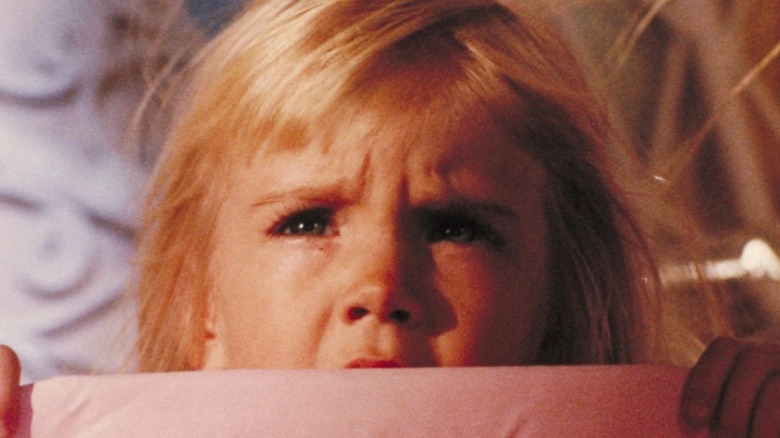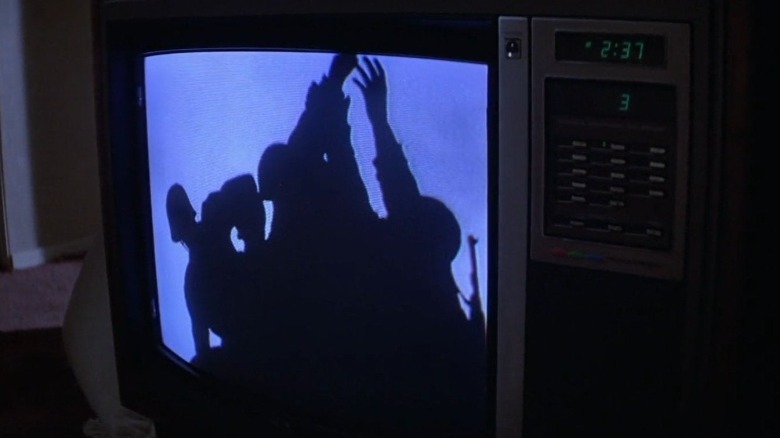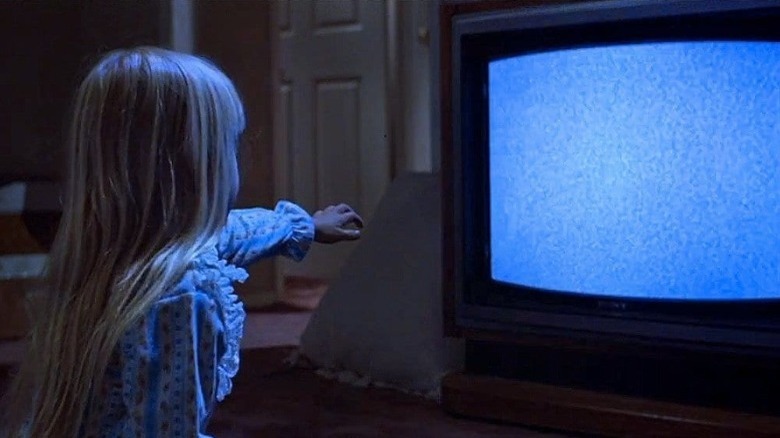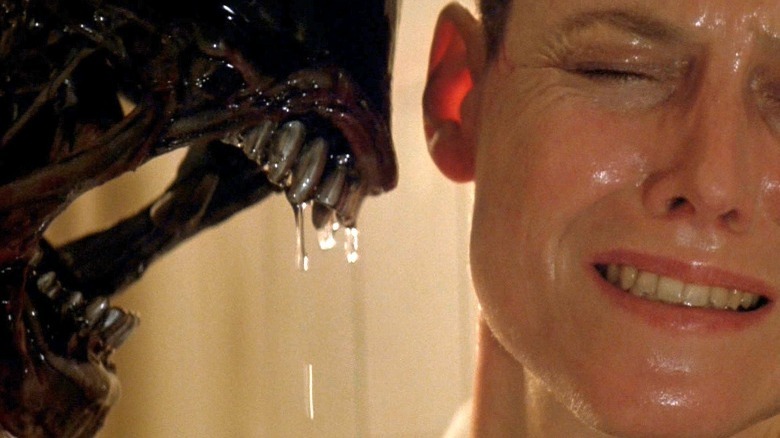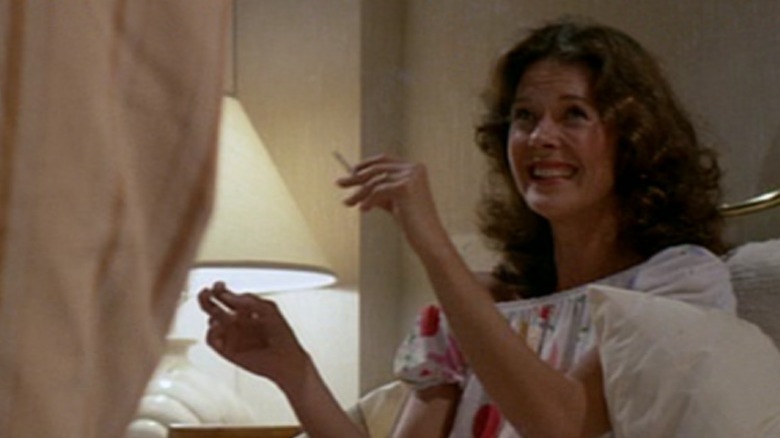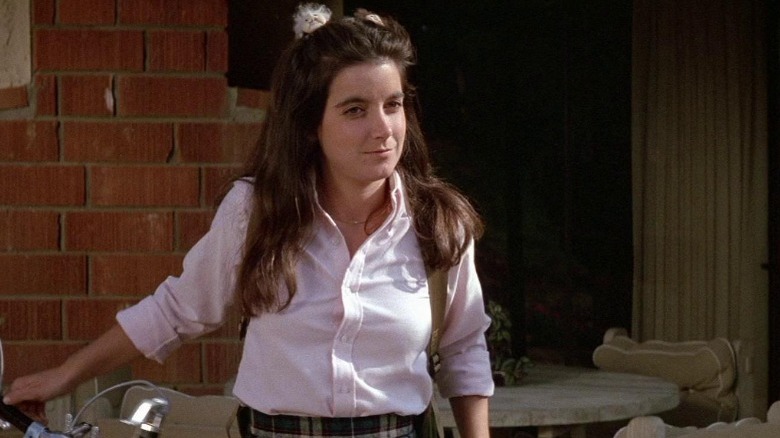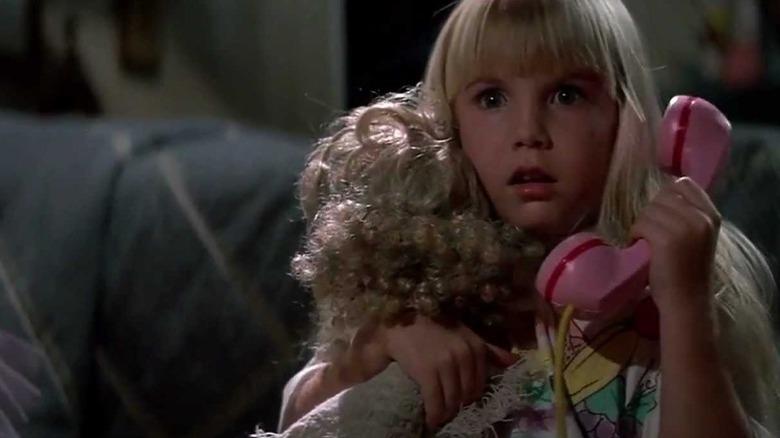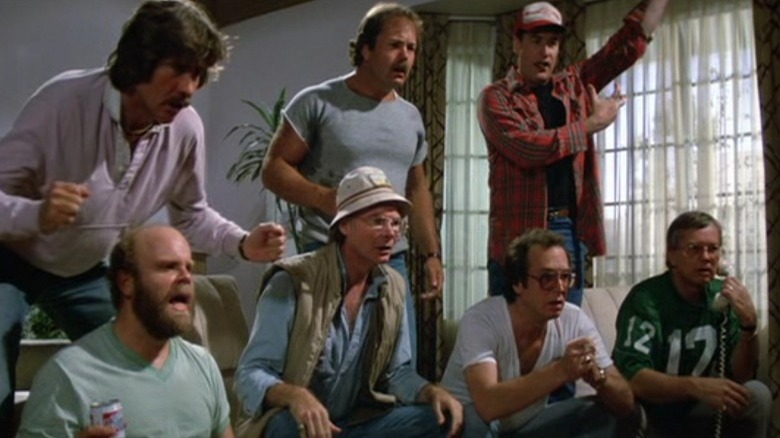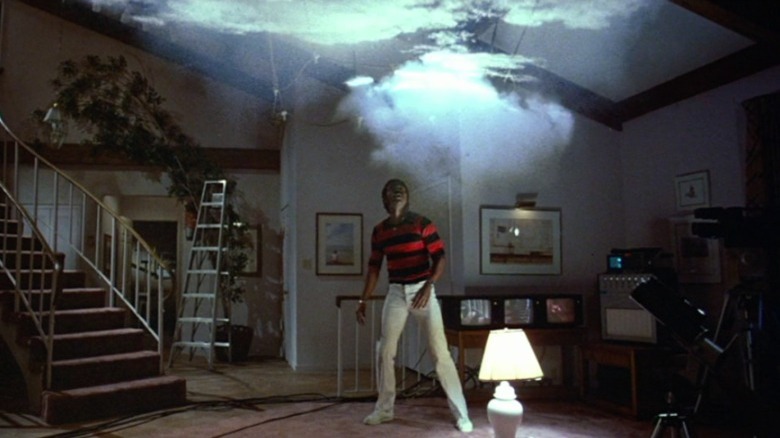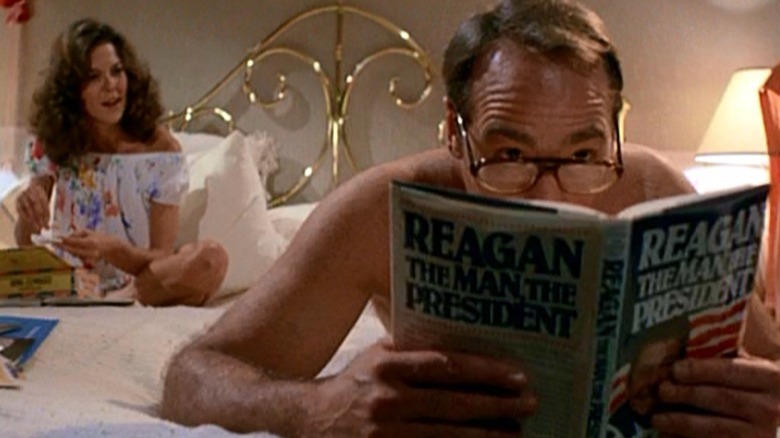Things Only Adults Notice In Poltergeist
If you're a child of the '80s, the nightmare-inducing "Poltergeist" films likely planted horrifying seeds in you that still haunt, decades later. The original 1982 film was directed by "Texas Chainsaw Massacre" filmmaker Tobe Hooper (although, depending on who you believe, it may have been really directed by producer Steven Spielberg), presenting an otherworldly horror tale that skirted the lines of an "R" rating (keep in mind, this is before PG-13 was invented), causing Spielberg to famously lobby for a more business-practical "PG" designation instead.
With a PG-audience at its fingertips, families — including young children — gathered together in theaters to witness the supernatural foul play afoot in the California planned community of the Freeling home, as spirits whisked away the youngest child in the family, Carol Anne (Heather O' Rourke), unleashing terrors upon her loved ones as they endeavored to retrieve the young girl.
The film made waves in 1982, contrasting sharply with another Spielberg classic, "E.T." even though both had similar themes of ominous invaders, suburban disquiet, and the innocence of youth giving way to encroaching danger. The cultural impact of "Poltergeist" ensured that the film would retain a legacy that would endure for many years to come.
Decades later, although the horror flick might be considered a classic, many details within the lives of the Freeling family are from an antiquated era. Modern audiences might look at TV static and wired telephones and find them every bit as preternatural as disembodied voices and monsters emerging from a TV. Set in a bygone era that now feels so far removed from the 2020s, here are some things only adults might understand about "Poltergeist."
TV stations playing the national anthem
"Poltergeist" begins where most stations would end in the '80s and before, as "The Star-Spangled Banner" blares through the television set while Steve Freeling (Craig T. Nelson) is passed out in his living room chair. While it might seem odd to modern audiences to begin a horror film with a patriotic score celebrating America, at the time that sound signified far more — and in retrospect, the effect is quite chilling.
For an audience that remembers the '80s, hearing the national anthem from the TV tells the viewer several things without saying a word. It is late at night — so late, in fact, that the networks are no longer broadcasting. The evening is in full swing, the entire Freeling family are gazing at the back of their eyelids, safe in their beds — or so they think. The TV is no longer a companion; they are alone.
What the younger generations of today may not understand is that the national anthem was traditionally the way TV channels would sign off for the night — hey, it could have been creepier; in 1982, CNN had an "end of the world" video at the ready. Following the song, programming would conclude, and static would consume the screen until regularly scheduled programming resumed again the next day.
By the mid-'90s, late night infomercials, 24-hour cable TV and endless re-runs of syndicated shows would fill the void of static air, eliminating any need for a station "sign off" signature. Later in "Poltergeist," the audience hears the national anthem again, this time resulting in a Pavlovian fear from the anticipatory, anxious audience. Even if you're too young to "get it," you can still appreciate the neat trick of turning our nation's most patriotic song into something akin to the Freddy Krueger jump-rope song.
TV Static
Following the late night national anthem, the Freelings' TV cuts to static — just like everyone else's back in those days, when it was a common occurrence to be awakened in an easy chair by the noise, disoriented by the bright light suddenly shining onto your half-asleep face.
Speckled, snowy screens are, oddly enough, now fond memories for folks who came of age in the '90s and before. So is the grating noise, but it was all a holdover from a bygone era when television broadcasting was new and people would "tune in" at specific times for programming, just as they had previously done for their favorite radio shows. The thought of a television station broadcasting 24 hours a day, seven days a week indefinitely seemed as preposterous as a movie theater or Broadway stage doing the same.
Static wasn't so much something being "broadcast" as it was lack of a broadcast. It represented the absence of a clear signal, that the particular network using the signal you had tuned to was no longer broadcasting anything. The term most commonly used in those days was "dead air," which seems in retrospect particularly appropriate for the "Poltergeist" films.
Of course, modern generations have been spoiled by an on-demand reality where modern technology brings us any of our favorite movies and television shows at any time; if you're awake at 3 in the morning, rather than the harsh sting of static, you're comforted by endless streaming channels eager to provide the latest binge-worthy comedy series or familiar film. If anything, the harshest message you might receive is the occasional "no signal" message.
In "Poltergeist," the static was put to now-iconic use, serving as a conduit for the spirits to interact with young Carol Anne. After Carol Anne became trapped in the realm of the dead, the Freeling family learned they could best hear their daughter when the TV set was tuned to dead air — in modern times, their only option for paranormal communication might be one of those "white noise" apps that helps parents get babies back to sleep.
Robbie was an Alien fan
Spielberg (especially in the '80s) had an affection for recognizing his buddies in the industry with film cameos and Easter eggs. His friendship with George Lucas was on full display in Robbie's room, of course, which was filled with enough "Star Wars" toys, posters, and merchandise to ... well, now make every middle-aged viewer insanely jealous. But beyond the shout-outs to a buddy (and likely amplification of their merchandising revenue), there was good reason to put beloved toys from popular franchises into a film like this: that reality felt real, lived in, and made the kid seem like he could be any child in our lives ... or, in the mirror.
This aesthetic still holds true with modern viewers of "Poltergeist," who are as likely fans of "Star Wars" (and its endless merchandise) as anyone was in the early '80s. However, eagle-eyed viewers may also notice another, more obscure, film property referenced in Robbie's room.
In 1979, Ridley Scott introduced the world to the H.R. Giger-designed extraterrestrial monstrosity at the center of the film "Alien." In the early scenes of "Poltergeist," before Robbie (Oliver Robbins) and Carol Anne's room is turned upside-down by the mischievous spirits, an "Alien" poster can be seen hanging precariously on the wall in the backdrop — among other items that would eventually be absorbed into the ghostly closet portal.
While "Alien" certainly had (and still has) a strong fanbase, modern youth is undoubtedly less aware of it than the likes of "Star Wars." Also, "Alien" is an R-rated franchise for its pervasive horror and violence, a film that most kids seeing PG-rated films have not viewed — and accordingly, an Easter egg that could only occur in the '80s.
The parents are casually smoking weed
Following decades of warnings from top health professionals, smoking has seen a dramatic decline since the '80s. Many American youths of today would likely be shocked to learn that places like restaurants, hotels and even airplanes once had segregated smoking and non-smoking sections. Even more shocking might be the idea that traditional working parents of the '80s would engage in recreational marijuana use in their bedrooms after the kids had been put to bed.
But Diane (JoBeth Williams) and Steve Freeling certainly have no qualms with sneaking a toke, as Mrs. Freeling is seen casually rolling her own joint and smoking it during a sequence of playful banter between the married couple. It was a different time — keep in mind, although they're middle-aged in the film, these were children of the '60s who had lived through Woodstock, the Summer of Love and the Vietnam conflict — and weed was very commonplace. Although illegal, marijuana would be very much seen by adults of the time as a way of releasing stress and keeping true to the notion of sticking it to "the man."
It's obvious that Tweety's coffin was a box formerly used for Mrs. Freeling's "stash," of which she seems to have plenty. Of course, modern audiences might very well be accustomed to seeing adults smoking marijuana, and may even smoke it themselves. After all, marijuana legalization efforts have largely been successful in recent years, and the country seems to have passed a tipping point that has now rendered weed legal in many states.
Nevertheless, it seems highly unlikely that you'd see the parents in a modern PG film smoking weed. Even if, to a 2020's audience, the most shocking part about the parents' drug use in "Poltergeist" might be that they feel the need to conceal it.
The oldest daughter is catcalled by construction workers
The #MeToo movement had a profound impact on society in many ways, and was a long-overdue reckoning for many as well. Far, far down that list is the fact that many of-the-time mindsets that made their way into popular entertainment are now cringe-inducing. But society is a constantly-evolving beast, so such modern repulsion is a good sign.
Sure enough, such chauvinistic, deplorable behavior makes itself known is a scene from "Poltergeist," where the Freeling's 16-year-old daughter Dana (Dominique Dunn) encounters some contractors working on the family home. As Dana grabs her bike and prepares to head off to school, the construction workers catcall the young girl, making comments like "I love that swing" and repeatedly stating "I love you."
Dana appears to flirt back, smiling and jokingly giving them the finger. But perhaps even more disturbing is the fact that her mom watches the entire exchange from her kitchen window and also laughs it off.
It is both impossible to imagine a similar scene in a modern movie, and a good thing that it is. While predatory behavior quite likely occurs just as often, society has come a long way towards not condoning it, and certainly not laughing it off like these characters (depicted by actresses, but carrying out the script and direction of men) are seen to do.
Wired telephones
Can you imagine being tethered to a kitchen wall? Or forced to sit in the living room in order to call your friend? It was a living hell — and one that was very real for children of the '80s, whose wired, rotary and football phones couldn't even text.
Siblings and parents alike could hear everything you had to say — especially when they picked up the extension. The cord would only let you go so far, even if you tried to sneak it under a bathroom door.
All these things may sound to a modern viewer like Montgomery Burns reminiscing about phrenology, but they have made children of the '90s and earlier appreciate what it means to have mobility — something younger generations likely take for granted.
Looking back on "Poltergeist" now, it really drives home the point of how complicated tethered phones made everyday life. Like the scene where Steve Freeling is talking to a client on the phone in the kitchen while attempting to get dressed for the day of work ahead of him, struggling to clothe himself around the cord — it seems in retrospect that as endearing as they may have been, those plugged-in phones just made everything more complicated.
Neighbors' TV remotes interfered with each other
It's the day of the big game, and your friends are scattered around your living room, munching on snacks and swigging down beer. At the height of everything, the channel abruptly changes to "Mr. Rogers' Neighborhood." Irritated, you switch the channel back, only to have Fred Rogers beaming at you again once more.
To a kid in the 2020s, this reality might feel about as plausible as a scene from "PAW Patrol." But back in the '80s, dogs were not driving firetrucks — and newly-wireless remote controls frequently got their signals crossed.
The year 1982 was right around the time that "wired" remote controls would have been abandoned by your average American. Previously only available for more expensive electronics, "wireless" remotes were suddenly becoming commonplace — although, there were still some kinks to work out. This was a pain felt by the character of Steve Freeling, who lived next door to a neighbor with the same brand TV set, meaning their remotes would change each other's channels. Played in "Poltergeist" for some oh-so-desperately-needed comic relief, the men would then proceed to argue over which channel to watch.
Living in a new development in the suburbs, where homes were often crammed closely together, this everyday irritant feels quite plausible for the Freeling family. Back in those days, unexpected program switching meant one of the neighbors had to give in and buy a different TV set. Today, it means somebody has downloaded the Apple TV remote app to their iPhone, hacked into your wi-fi and is messing with your streaming box. But, you could still do that to turn their set to "Mr. Rogers" during the big game, which would be as hilarious now as it was five decades ago.
What are the Yellow Pages?
When things start to go sideways for the Freelings and they don't know who to call, Diane remarks: "I already looked in the Yellow Pages. 'Furniture Movers' we got. 'Strange Phenomenon,' there's no listing."
You can imagine a kid in 2021 hearing this line and calling in grandpa from the other room to translate. You can just as easily imagine a kid from today time traveling to 1982 and offering "Let's Google it" as a solution, only to receive similar head tilts of confusion.
In essence, the two phrases mean the same thing, just with far different methodologies. For decades, if you needed the name and phone number of a business, you'd whip out an enormous phone book and "let your fingers do the walking" while you look in the Yellow Pages. Nowadays, you let your fingers do the typing, and put your request in a search engine.
Prior to the Internet largely rendering them extinct, massive phone books were distributed to each and every home (and were often located at pay phones, but that's a history lesson for another day), containing phone numbers of residents in the area; the Yellow Pages were a specialized subsection of these phone books, listing businesses under subheadings like "Furniture Movers." And yes, the pages were yellow, making them easier to differentiate.
It takes a mountain of hardware to record audio and video
Eventually, the quasi-Ghostbusters arrive at the Freeling house — and go to work attempting to retrieve the family's lost daughter. Dr. Martha Lesh (Beatrice Straight) and her two associates Mitchell (Richard Lawson) and Casey (Martin Casella) arrive on the scene, armed with a mountain of hardware that seemingly fills an entire U-Haul van. The trio set up shop in the family's living room, with cameras strategically placed around the house and large bulky screens for monitoring the activity.
When Dr. Mitchell follows the crew around the room with a camera, it looks like an extra appendage sitting atop his shoulder. Additionally, the camera is plugged into an outlet, once again tethering an '80s character (and also making for a dangerous tripping hazard). Unless this paranormal crew brought extension cords, their scope of coverage would have been severely limited.
To a member of a more modern generation, all this bulky equipment looks positively prehistoric. In fact, most of what Dr. Lesh and her team are trying to accomplish could now be done with a smartphone.
Steve reading book about U.S. President Reagan
Aside from all the outdated technology and '80s pop culture references, another image that drives perfectly crystallizes the era is dad Steve's selection of reading material. While Diane lights up her joint in bed, Steve is studiously engaged in "Reagan: The Man, The President." Make no mistake: the image of one child of the '60s rolling a spliff while the other brushes up on The Gipper is a subtle but intentional dig at the perceived hypocrisies of '60s liberals, now grown up and clinging to their freewheeling ways, yet voting for conservative Reagan and the so-called "decade of greed" he would oversee.
The 40th President of the United States, Ronald Reagan served two terms from 1981-1989. His relatively new presidency was in full swing during the events of "Poltergeist," making him a prominent figure in global politics and representing a fundamental sea-change after the presidency of Jimmy Carter.
While the film never seeks to make any direct political commentary, subtexts are prevalent throughout "Poltergeist" with undertones highlighting societal ignorance, greed and selfishness. When "Poltergeist" hit theaters, the country was at the height of the Cold War and all eyes were on President Reagan in hopes that a new "Morning in America" was indeed dawning. For adults looking back on "Poltergeist," regardless of their political leanings, they might appreciate the time-capsule of political nostalgia — even if their kids think of Reagan in the same terms as George Washington and Abraham Lincoln, just another long-gone president that needs to be studied in history class.
